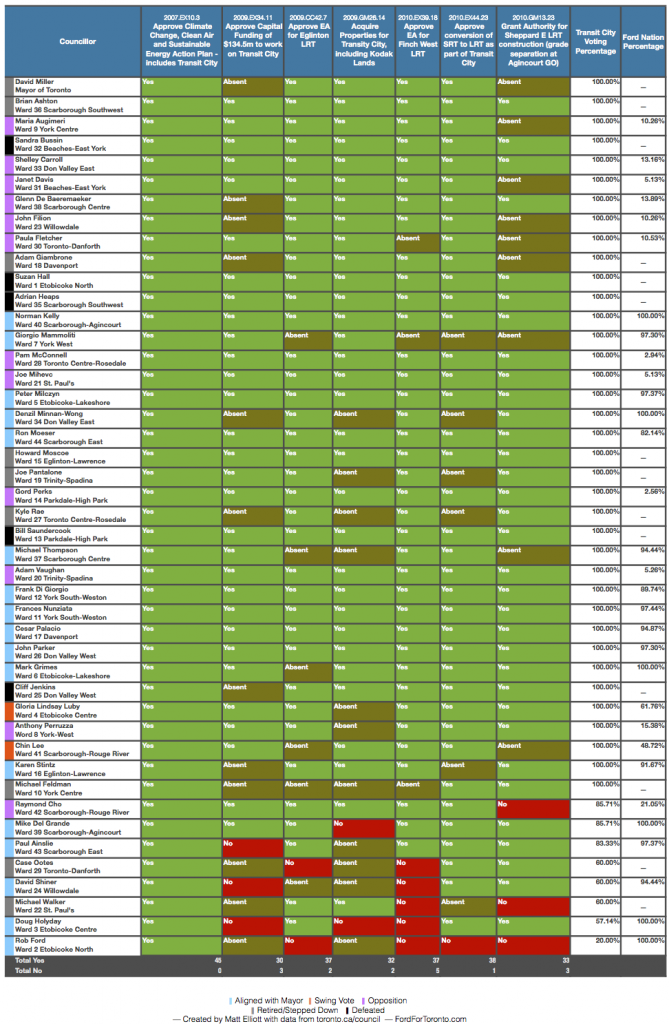
An April 2010 photo shows David Miller distributing "Save Transit City" flyers at Eglinton station. The woman pictured at far left sure looks familiar. (Photo by Brad Pritchard / InsideToronto)
1. We probably should have seen this coming
In April 2010, Karen Stintz spent a morning at Eglinton station with then-mayor David Miller. In the wake of provincial cuts to funding, the two of them distributed “Save Transit City” flyers to commuters. “I fully support Mayor Miller and his initiative and I’m proud to stand here beside him and get the message out,” she told the National Post.
That was a big statement. Stintz and Miller rarely saw eye-to-eye. It’s probably fair to describe her as a perpetual thorn in his side. She once dismissed his agenda as “bags, bottles and bicycles.” But when it came to funded and realistic transit planning, she was willing to work with the guy in the mayor’s chair. She was willing to be an advocate.
So what did we really learn about Karen Stintz this week? That she’s willing to stand up for achievable and realistic transit planning? That she’s open to working with people across the political spectrum to ensure those plans move forward? That she believes in Light Rail Transit?
We already knew these things about Karen Stintz.
2. Unavoidable truth: Transit City’s back
The light rail plan endorsed by council on Wednesday has got all sorts of names. Some called it the “Stintz plan.” Others called it the “Council plan.” The mayor, as is his way, called it “streetcar city.”
But whatever. Ignoring the politics of it — and maybe it’s not wise to point this out — it’s impossible to ignore that this plan is, essentially, a direct continuation of Transit City. It’s pretty well the same plan we would have seen go forward had David Miller remained in office for another term.
No bones about it: David Miller’s legacy got a shot in the arm on Wednesday.
3. Will the mayor get his Sheppard Subway anyway?
An interesting twist at this week’s meeting came from a Stintz motion that called for an “expert panel” brought together over the next month to discuss what to do with transit on Sheppard Avenue. The light rail plan — currently on the books as part of Transit City — has faced opposition because it’ll force an inconvenient transfer at Don Mills station on the Sheppard Subway line.
My first thought was that this panel was just an attempt to throw a bone toward Scarborough councillors, and that they’d ultimately conclude that light rail was the way to go. But during an appearance on NewsTalk 1010 Thursday morning, Councillor Adam Vaughan gave the impression that he expected the experts to support a one- or two-stop subway extension to Victoria Park.
A small subway extension would be an interesting outcome, serving two purposes: first, it shoves the question of what to do on Sheppard in the long-term off to the far-flung future. Another council and another mayor can figure it out. Second, it gives the mayor — even after all of his bitching and hyperbole and dirty tricks — a chance to deliver on a campaign promise.
4. Dirty Tricks & Pettiness
I mentioned dirty tricks: it’s worth noting how desperate and petty Ford and his allies got as yesterday’s council meeting rolled forward. Coming back from the lunch break, rumour was that the Ford allies were going to attempt the procedural equivalent of  taking the ball and going home. The talk was that the mayor would try to force a halt to the meeting by intentionally breaking quorum in the council chamber.
After a tense delay, Ford and a handful of allies did return to the chamber so the meeting could resume. There weren’t enough of them to break quorum.
They followed that up with further petty procedural meddling. When it came time to excuse councillors who were absent from the meeting, Councillor Denzil Minnan-Wong insisted on separating the vote into two parts. He wanted to vote against excusing Gloria Lindsay Luby, who had booked a vacation before talk of this special council meeting got started.
In a show of macho pride made completely bizarre because all it does is further alienate a councillor who is ideologically aligned with Rob Ford on most issues, Minnan-Wong voted against excusing her. So did Paul Ainslie, Mike Del Grande, Frank Di Giorgio, Doug Ford, Giorgio Mammoliti, Frances Nunziata and the mayor.
This is not how you win friends and influence people.
5. What happens next?Â
As expected, the province was quick to lend legitimacy to council’s decision. In fact, we learned today that Dalton McGuinty told Rob Ford days before the meeting that he would not support the mayor’s subway plan without council’s endorsement.
The remaining piece of the puzzle is Sheppard. Council will come back for another special meeting on March 21, at which time we’ll know whether we’re looking at subway or light rail in that corridor. That should be another fun meeting for the mayor to sit through.
Meanwhile, Rob Ford’s doing his best to make himself relevant to this debate. He’s spent damn near every hour since the vote attempting to spark public outcry over council’s decision, but there’s no real indication that he’s going to get anywhere with this plan. Yeah, the average person on the street will tell you that subways are awesome and we should have more of them, but that same person might also tell you that we should have libraries that are open 24 hours a day, free recreation programs, no property taxes and a fully-developed waterfront built by 2015.
Politics is about balancing what people want with fiscal reality — you can’t give people services you can’t pay for. You have to accept trade-offs to ensure public money is spent to maximum public benefit. You’ve got to be efficient and realistic. It’s weird that Rob Ford doesn’t understand this.





